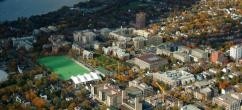Master Plan Document
Maintaining Dalhousie鈥檚 competitive edge
The Master Plan documents map out a vision for Dalhousie鈥檚 physical space in the future, anticipating development to address unmet needs and future challenges.
The plan for the three Halifax campuses was approved in October 2010 and looks ahead to 2020. It identifies priorities for maintenance and new construction to ensure that facilities renewal funds are spent effectively.
The was approved in spring 2017 and is titled FRAMEWORK CAMPUS DEVELOPMENT PLAN: TRANSITION, SUSTAINABLILITY AND GROWTH.聽The Nova Scotia Agricultural College (NSAC) became the Dalhousie Agricultural Campus (DAC) in 2012.聽As the title of this report suggests, this is an interim framework plan rather than a typical campus master plan due to the transition underway that needs time to fully define expectations of future academic programs, enrollment growth and the capital funds needed to accommodate such growth. This report is therefore intended as a framework to guide campus development decisions as the campus and its academic programs - both agricultural and other - evolve from periods of transition to sustainability and growth.
The university also has an聽Energy Master Plan聽document which is the culmination of a comprehensive analysis of the current and future use and production of energy and water on campus. The purpose of this document is to guide Dalhousie鈥檚 future energy development. This will be achieved by examining the costs and strategies required for the university to grow at forecast rates, while simultaneously improving energy security and striving to achieve short-term and long-term reductions to the university鈥檚 utility costs and carbon footprint. 聽
Improving current deficiencies and accommodating future needs
The Master Plan documents represent years of consultation and several phases of work in the development of a comprehensive framework plan for Dalhousie University's future. They focus on:
- Improving and increasing academic, research and administrative facilities.
- Fostering student-based learning and enhancing student environments.
- Strengthening the university鈥檚 capacity to promote private and public capital funding.
- Identifying improvements and efficiencies in managing the physical environment and its further development.

